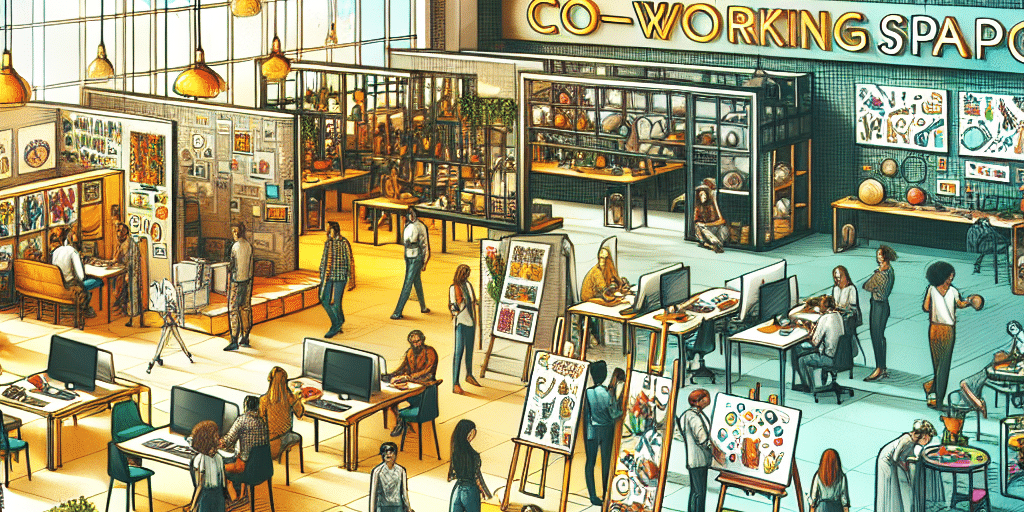Title: The Rise of Coworking Spaces with Creative Workshops: Concept and Design
In recent years, the professional landscape has seen a transformative shift, with coworking spaces becoming the new norm for freelancers, startups, and even established companies. However, the coworking concept continues to evolve, presenting new hybrid models that cater to a diverse range of professional needs and creative pursuits. One such innovative model is the combination of coworking spaces with creative workshops. This fusion not only offers a place to work but also a haven for artistic expression and a hub for creative collaboration.
Conceptual Framework: Merging Work with Creativity
The core idea behind combining coworking spaces with creative workshops is to create dynamic environments where work meets creativity. Traditional coworking spaces, typically characterized by desks, meeting rooms, and communal areas, primarily focus on providing a conducive and flexible work environment. The addition of creative workshops expands on this concept by incorporating spaces where individuals can engage in artistic, craft-related, and innovative activities.
This model is attractive to a vast array of professionals who value creativity as a vital component of their work process. Artists, graphic designers, artisans, and even tech developers who rely on a creative approach to problem-solving find these spaces particularly appealing. The integration allows members to shift from their work mode to a creative mindset seamlessly, thus fostering an environment of holistic productivity and innovation.
Design Elements: Crafting Inspiring Spaces
The design of these hybrid spaces plays a crucial role in their success. Unlike traditional coworking environments, these spaces require careful planning to accommodate both productivity-focused and creativity-driven areas. Here are some key design elements:
-
Zoning and Flow: Effective zoning ensures that noisy, messy, or collaborative activities in workshop areas do not disrupt the quieter, focused workspaces. The flow between these zones is achieved through thoughtful architecture that incorporates soundproofing and strategic layout design.
-
Flexible Furniture: Modular furniture that can be easily moved and reconfigured is essential. Workspaces may need to transform from individual desks to collaborative tables or open workshop areas, depending on the users’ needs.
-
Artistic Ambiance: Creative workshops benefit from an inspiring ambiance. This might include mood lighting, the use of vibrant colors, or the display of local artwork and crafts. Such elements not only motivate but also create a unique identity for the space.
-
Tool and Equipment Accessibility: For those engaging in hands-on creation, easy access to tools and equipment is paramount. This could range from traditional art supplies to high-tech devices like 3D printers or laser cutters, depending on the focus of the workshop.
- Community and Collaboration: Beyond physical design, these spaces thrive on the spirit of community. Hosting regular workshops, networking events, and exhibitions can help foster a sense of belonging and stimulate creative collaborations among members.
Benefits and Challenges
The integration of coworking spaces with creative workshops offers numerous benefits. It nurtures innovation by providing the tools and space for experimentation, promotes a diverse community of professionals, and enhances work-life balance by blending productivity with pleasurable creative activities.
However, this model is not without challenges. Balancing the needs of different users, managing the cost of maintaining specialized equipment, and ensuring that the unique requirements of a creative space are met can be complex. The success of such spaces depends largely on the ability to maintain flexibility and adaptability in both design and management.
Looking Ahead: The Future of Workspaces
As work continues to evolve in the 21st century, the demand for spaces that support both professional and personal growth is likely to increase. Coworking spaces with creative workshops represent a forward-thinking step in this direction, offering environments where innovation and inspiration thrive side by side.
By continuing to blend work with creativity, these spaces promise to redefine how we think about productivity and community in the workplace, making them an exciting prospect for the future of work.







